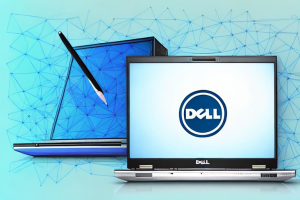How to upgrade the graphics card on a Dell OptiPlex 7060
8 min read
A dell optiplex 7060 desktop computer with an open case
If you’re someone who uses a Dell Optiplex 7060 for either work or personal use, you may have noticed that the graphics card that is included with the system isn’t up to par with your needs. This is where upgrading the graphics card on your Dell Optiplex 7060 can come in handy. In this article, we will go through the process of upgrading the graphics card on your Dell Optiplex 7060 in exhaustive detail, step-by-step.
Understanding the Dell OptiPlex 7060 and its graphics card
The Dell Optiplex 7060 is a powerful and versatile computer that can handle a wide variety of tasks. However, its standard graphics card might not meet your needs, especially if you’re a gamer, an editor or a designer looking to use heavy software. The Dell Optiplex 7060 uses a PCIe x16 slot to house its graphics card. Upgrading to a better graphics card can significantly improve its gaming performance, visual output while streaming, rendering performance and even allow you to work smoothly with heavier programs.
When upgrading the graphics card on the Dell Optiplex 7060, it’s important to consider the power supply unit (PSU) as well. A more powerful graphics card will require more power, and the standard PSU that comes with the Optiplex 7060 might not be sufficient. It’s recommended to upgrade the PSU to at least 500 watts to ensure stable and reliable performance. Additionally, make sure to choose a graphics card that fits within the physical dimensions of the Optiplex 7060’s case, as some larger graphics cards may not fit properly.
Why upgrading the graphics card on a Dell OptiPlex 7060 is necessary
In most cases, the graphics cards that come with pre-built desktops aren’t powerful enough to handle heavy games and software, and they become obsolete more quickly than the computer itself. It is always worth upgrading the graphics card on your Dell Optiplex 7060 if you require a better computer performance or smoother workflow experience. By upgrading the graphics card, you can enjoy better visuals and smoother performance, which can be utilized for gaming, designing or editing videos and images.
Additionally, upgrading the graphics card can also improve the overall lifespan of your computer. A more powerful graphics card can handle more demanding tasks, which means your computer won’t have to work as hard to complete them. This can reduce wear and tear on your computer’s components, ultimately extending its lifespan. Furthermore, upgrading the graphics card can also increase the resale value of your computer if you plan on selling it in the future.
Preparing to upgrade the graphics card on a Dell OptiPlex 7060
Before you upgrade your Dell Optiplex 7060’s graphics card, there are several things that you need to do to prepare. Firstly, make sure to back up all essential data as the upgrade process might require you to make drastic changes to your system. Secondly, gather all the tools you’ll need for installation, including screwdrivers, grounding cords, and thermal paste. Lastly, turn off and unplug your computer before you start upgrading the graphics card.
Once you have completed the preparation steps, you can begin the process of upgrading your graphics card. Start by opening the computer case and locating the current graphics card. Carefully remove it by unscrewing any screws or clips holding it in place and gently pulling it out of the slot.
Next, insert the new graphics card into the slot and secure it with screws or clips. Apply a small amount of thermal paste to the graphics card before reattaching any cooling fans or heat sinks. Finally, close the computer case and plug in all necessary cables before turning on your computer to ensure that the new graphics card is working correctly.
Tools you need to upgrade the graphics card on a Dell OptiPlex 7060
- Screwdrivers
- Grounding cords
- Anti-Static Wrist Strap
- Thermal paste
- New Graphics Card (compatible with your Dell Optiplex 7060)
- Driver Installation Disk
Before upgrading the graphics card on your Dell OptiPlex 7060, it is important to check the power supply unit (PSU) of your computer. Upgrading to a high-end graphics card requires more power, and if your PSU is not powerful enough, it can cause system instability or even damage your computer. Make sure to check the wattage of your PSU and compare it with the recommended wattage of the graphics card you want to install.
Another important factor to consider is the physical space inside your computer case. High-end graphics cards are usually larger in size and require more space. Make sure to measure the available space inside your computer case and compare it with the dimensions of the graphics card you want to install. You may need to remove some components or rearrange them to make room for the new graphics card.
How to remove the old graphics card from a Dell OptiPlex 7060
The first step in upgrading your Dell Optiplex 7060’s graphics card is to remove the old one. To do this, you should open up the computer case using the screwdrivers, locate the PCIe x16 slot, and carefully remove the old card from the slot. Make sure to release any locking mechanisms before you pull out the graphics card. Once the graphics card is out, carefully remove the thermal paste and clean the PCIe x16 slot before installing the new card.
It is important to note that before removing the old graphics card, you should first turn off the computer and unplug it from the power source. This will prevent any electrical damage to the computer or to yourself. Additionally, it is recommended to wear an anti-static wristband to prevent any static electricity from damaging the components of the computer.
After removing the old graphics card, you should also check the manufacturer’s instructions for any specific steps or precautions to take when installing the new card. This may include installing drivers or updating the BIOS. It is also important to ensure that the new graphics card is compatible with your computer’s power supply and that it has enough power to support the new card.
Choosing the right graphics card for your Dell OptiPlex 7060
Choosing the right graphics card for your Dell Optiplex 7060 is very important as it determines the overall compatibility, performance and power consumption of your system. You can either choose an Nvidia or AMD graphics card for your Optiplex 7060, based on your specific budget, game requirements, video editing tasks or rendering needs. Ensure that you purchase a graphics card that is compatible with your dell optiplex 7060, and one that can fit in the PCIe x16 slot.
It is also important to consider the power supply unit (PSU) of your Dell Optiplex 7060 when choosing a graphics card. A high-end graphics card requires more power, so you need to ensure that your PSU can handle the power requirements of the graphics card. If your PSU is not powerful enough, you may experience system crashes or instability. It is recommended to have a PSU with at least 500 watts for a mid-range graphics card and 750 watts for a high-end graphics card.
Installing the new graphics card on your Dell OptiPlex 7060
After choosing the right graphics card for your computer, the next step is to install it. Gently place the new graphics card in the PCIe x16 slot and make sure it is tightly secured by the locking mechanism. Then, attach the power cables (6/8-pin) from the graphics card to the power supply unit. Lastly, apply a thin layer of thermal paste to the graphics card and re-attach the cooling fans to avoid overheating.
It is important to note that before installing the new graphics card, you should uninstall the drivers of the old graphics card. This can be done by going to the Device Manager, right-clicking on the old graphics card, and selecting “Uninstall”. Once the drivers are uninstalled, shut down your computer and proceed with the installation of the new graphics card.
After installing the new graphics card, it is recommended to update the drivers to ensure optimal performance. You can download the latest drivers from the manufacturer’s website or by using a driver update software. Once the drivers are updated, you can test the graphics card by running benchmark tests or playing graphics-intensive games.
Configuring your new graphics card for optimal performance on a Dell OptiPlex 7060
After installing the new graphics card on your Dell Optiplex 7060, you should configure it to ensure optimal performance. Install the proper drivers from the installation disk that was supplied with the graphics card. Ensure that you’re running the latest driver versions. You should also configure settings such as resolution, refresh rate, and other settings to match the card’s specifications for better performance.
Additionally, it’s important to ensure that your power supply unit (PSU) can handle the power requirements of the new graphics card. Check the specifications of the graphics card and compare it to the wattage of your PSU. If your PSU is not powerful enough, you may experience performance issues or even system crashes. Upgrading your PSU may be necessary in this case.
Testing the new graphics card on your Dell OptiPlex 7060
Once you’ve installed and configured the new graphics card, the next step is to test it. Check if your computer detects the graphics card by opening the Device Manager or NVIDIA Control panel and ensure that it’s running correctly. You can also test the performance using benchmarking software or a game to check if there’s a significant improvement in the frame rates, rendering time or video output quality.
It’s important to note that testing the graphics card may require adjusting the settings on your computer. You may need to adjust the resolution, refresh rate, or other display settings to optimize the performance of the graphics card. Additionally, if you encounter any issues during testing, such as crashes or glitches, you may need to troubleshoot the problem by updating drivers or adjusting settings.
Once you’ve completed testing and are satisfied with the performance of the graphics card, you can enjoy a better visual experience on your Dell OptiPlex 7060. Whether you’re using your computer for gaming, video editing, or other graphics-intensive tasks, a high-quality graphics card can make a significant difference in the quality and speed of your work.
Troubleshooting common issues when upgrading the graphics card on a Dell OptiPlex 7060
Upgrading your graphics card might cause some issues like the system failing to boot up, overheating, or driver related problems. If you face any of these issues, use the installation disk to reinstall the graphic card drivers and check if the necessary cables are connected. You might also consider asking for assistance from your local computer technician or hardware support.
Wrapping up: Enjoying improved performance with your upgraded graphics card on a Dell OptiPlex 7060
The process of upgrading your Dell Optiplex 7060’s graphics card might seem daunting. But it’s worth it once you see and experience the difference in your computer’s performance and capabilities. Upgrading your graphics card can open up a whole new world of possibilities for gaming, video editing, and other specialized tasks without having to spend a fortune on a new computer system. Remember to always research, and consult a computer expert if you’re unsure of any step in the process. Happy upgrading!


